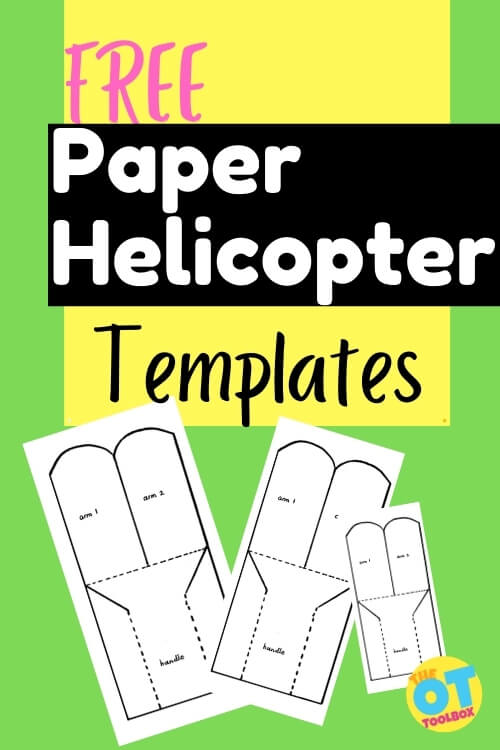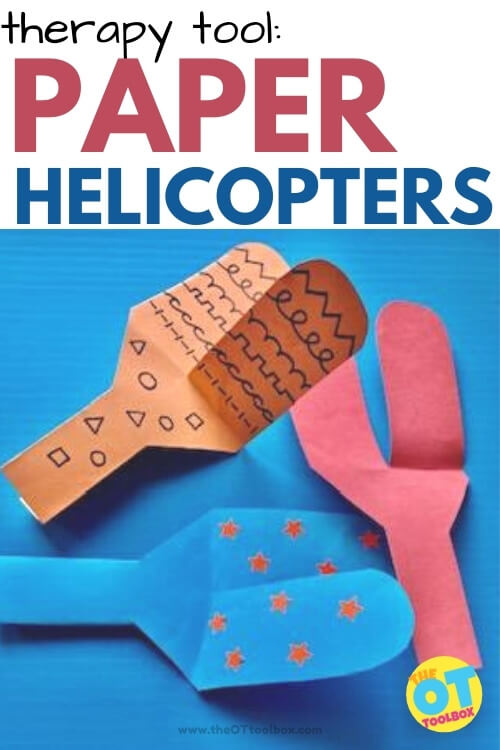Kids love fine motor crafts and this paper helicopter is just that! If you are needing an occupational therapy activity that develops scissor skills, visual motor skills, fine motor dexterity, pinch and grip strength, eye-hand coordination, balance, endurance, and more…than grab this paper helicopter template as a therapy tool for kids!

Paper Helicopter
You might be thinking, “What is a paper helicopter?” Well, a paper helicopter is a folded piece of paper that flutters and flies through the air. Similar to a paper airplane, a paper helicopter requires folded paper and is a fun hands-on activity for children and all ages. Paper helicopters, or paper twirlers, are also a low-prep activity that can be adapted accordingly to meet a variety of therapy goals.
I love simple occupational therapy activities that use materials found around the home. That’s why making paper helicopters (or paper twirlers) is one of my favorite paper activities.
Paper helicopters is an easy paper project that can be modified in so many ways to cater for children of various ages and children working on different skills. As an added bonus the kids adore the surprise spin revealed at the end.

How to make a paper helicopter
All you need to make a paper helicopter is a few materials found around the home:
- Paper
- Scissors
- Pencil
- Paper clip
Thin cardboard or empty cereal boxes can also be used for this activity.
- Print out the paper helicopter template. (Access the template below).
- Cut out the template.
- Trace the template onto paper.
Copy or print out the template for the paper twirler (picture 2). You can give your child a copy of the template or you could encourage them to trace the template. Tracing is a good way to develop pencil control and planning. Children need to work carefully to follow the lines that they trace. Tracing also requires that you stabilize the page with you non-dominant hand encouraging bilateral co-ordination.
Other ideas for developing co-ordination between the left and right sides can be found at Bilateral co-ordination activities.
Once the child has a template or outline you can decide how to decorate the paper twirler.
One option is to stick the page onto a vertical surface and encourage the child to colour in the twirler. Colouring on a vertical surface will develop the child’s upper body strength and encourage wrist extension in a child that may flex / bend their wrist when colouring.
Using a vertical surface can build up physical endurance for drawing and colouring and changing up the way you colour in can motivate a child who may be averse to colouring in. Working on an a vertical surface provides more information and activity ideas around working on a vertical surface.
If you colour in on the desk you can opt for the type of writing utensil you would like to use. This includes pencils, chalk, coloured pens, markers, pastels. Each choice provides a different feedback and colouring experience for the child. Colouring with crayons provides some more insight on the use of crayons for drawing and colouring activities.
Instead of colouring you could choose to decorate the paper twirler with stickers. Children will need to use a good refined pincer grip to peel off the stickers and sticking them. The size of the sticker will determine how much refined control the child will need.
When I am working on visual-motor integration / copying I will draw patterns on one half of the paper twirler and the child to copy the patterns on the other half of the paper twirler. Being able to transfer visual information accurately onto paper is an important skill to develop in preparation for the development of handwriting skills. The importance of copying accurately is further developed in Visual motor skills
Another option is to practise drawing shapes on the template.
Letters and numbers can be drawn on the arms of the paper twirler. To add a sensory component I trace a number or letter on the child’s back with my finger and they have to guess what it is. If they guess correctly they can write the letter or number onto their paper twirler.
For children practising their body image you can draw a person on each arm of the paper twirler. This can be the pilot and passenger ready to go for a spin.
For older children I turn the template horizontally and draw lines on the two arms of the paper twirler and we practise our handwriting skills. The child can write two wishes, two destinations they would like to go to, something that makes them happy and something that makes them mad. Writing content can be adapted to the therapy session.
Once the paper twirler has been decorated it will need to be cut out. Give the child the instruction to cut along the solid black line. Make sure to pint out the solid lines and the dotted lines so that the child can differentiate between the two. Cutting on straight lines precedes cutting on curves so you will have to gauge how much assistance your child will need. For more information on cutting have a look at Scissor skills.
The final step is to fold on the dotted lines. Piece 1 and 2 fold back to create a handle. One of the arms of the paper twirler folds back slightly and one of the arms folds forward slightly.
Add a paper clip to the bottom to add a small weight that centers the paper twirler. This is just one more way to play games with paper clips!
The paper twirler is ready to spin. Hold it by the handle and let it drop to the floor. Watch it spin! (paper twirler video)
paper helicopter template
Want to add a paper helicopter craft to your therapy line-up? There are many reasons to do so!
Enter your email address into the form below to grab a free paper helicopter template and start developing many skill areas!
Contributor to The OT Toolbox: Janet Potterton is an occupational therapist working predominantly in school-based settings and I love, love, love my job. I have two children (if you don’t count my husband!), two dogs, one cat, two guinea pigs and one fish. When I am not with my family or at work I try to spend time in nature. The beach is my happy place.






